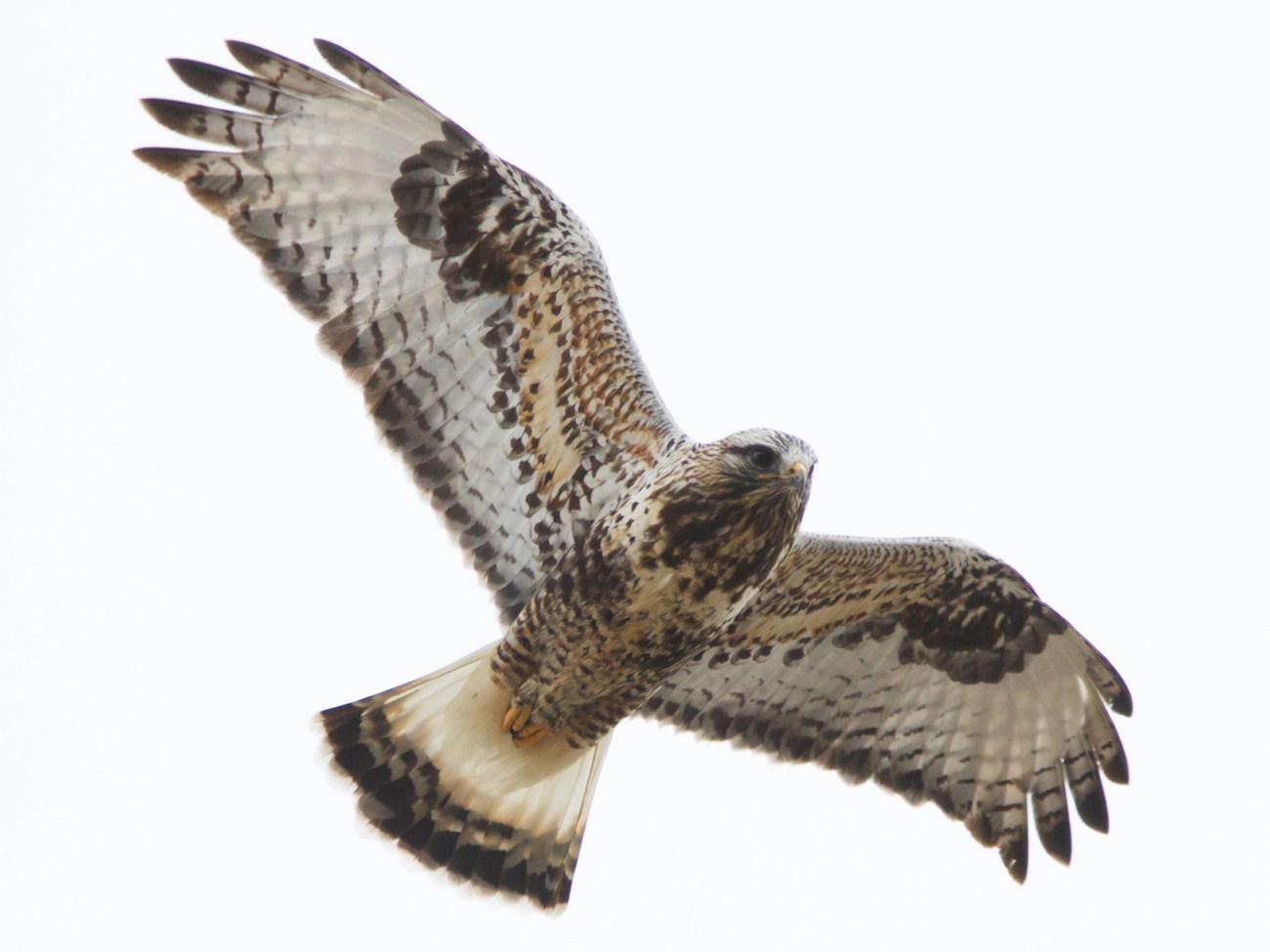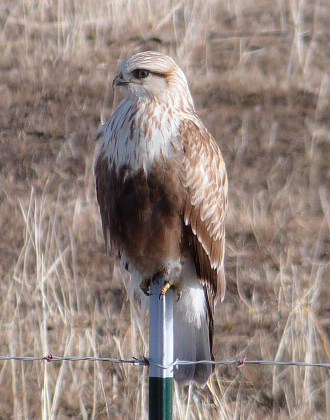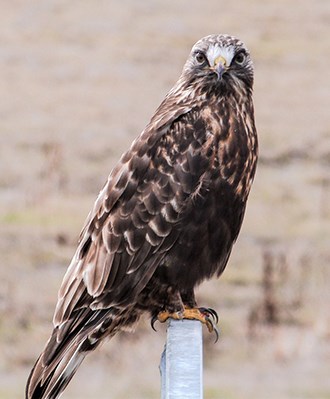Last updated: December 20, 2019
Article
Rough-legged Hawk

Neil Paprocki
General Description
As we move into the dead of winter, a winged visitor from the far north moves south into our region in search of food-rich wintering grounds. The rough-legged hawk is a large, soaring buteo in the Accipitridae family of hawks, eagles, and kites. A good look at its plumage distinguishes it from its buteo cousins, the red-tailed, ferruginous, and Swainson’s hawks. From below, the adult rough-legged hawk has a mottled dark and light appearance, with large, black wrist patches (“carpal patch”) and a light tail ending in a well-defined, dark band. Juveniles have a dark bellyband, a lighter, dusky tail band, and lighter eye color. This hawk’s plumage is actually quite variable, however, ranging from lighter coloration (“morphs”) to darker morphs and variations within each morph. Unlike many North American raptors, the adult female is readily distinguished from the adult male by her solid, dark bellyband. Similar to other raptors, however, rough-legged hawks exhibit reversed sexual-size dimorphism, whereby females are larger than males. In flight, its wings angle slightly upward in a dihedral.
The name, “rough-legged,” comes from its feathered lower legs (tarsi). This unusual characteristic—also shared by golden eagles and ferruginous hawks—is one of several cold climate adaptations, another being its dense layer of downy body feathers.

Dick Ashford
Habitat and Range
One of the most cold-adapted hawks, the rough-legged hawk breeds in the arctic tundra of North America, Europe, and Asia, where low-lying vegetation reveals abundant small rodent prey. On the treeless tundra, these hawks place their nests on low cliffs, riverbanks, outcroppings, and even directly on the ground when prey densities are high.
All rough-legged hawks migrate south for the winter. In North America, they spend November to April concentrated in southern Canada and the northern United States, rarely venturing further south than Arizona and New Mexico. Wintering grounds are structurally similar to their open tundra breeding habitat—prairies, shrubland, marshlands, grasslands, and agricultural fields, wherever small rodents are abundant and visible.

Dick Ashford
Behavior and Diet
Rough-legged hawks hunt from the air more than other buteos, hovering (flapping) or “kiting” (no flapping) in place high above the ground and glancing back and forth in search of prey. On their arctic breeding grounds, they eat primarily voles and lemmings, though birds, ground squirrels and other small prey are also taken. One study suggested that rough-legged hawks use the ultraviolet signal of vole urine, which they can see, to identify choice foraging areas. Over the winter, their diet also includes carrion, and even the occasional freshly killed prey stolen right from the talons of another raptor—often a northern harrier. Stealing another’s prey, or stashed food, is known as kleptoparasitism.
Reproduction
Arriving back north in April–May, adults form monogamous pairs and build a stick nest. Cleverly adapting to the stick-poor tundra, they sometimes fit caribou bones into the nest! After lining the nest with softer layers of grass, sedges, small twigs, molted feathers, and downy material, the female lays 3–5 oval shaped, pale greenish or blue eggs with dark blotches or streaks on the large end. Fed by the male, the female incubates the eggs until they hatch in about a month. At 16 days, nestlings can swallow lemmings whole! In 5–6 weeks, the young fledge. The short arctic summer limits nesting to once per year.
Conservation
Like all raptors (and other migratory birds), rough-legged hawks are protected by the 1918 Migratory Bird Treaty Act. Though this species is widespread and of low conservation concern, human-caused threats include direct persecution (shooting), vehicle collisions, and climate change. A recent study on Bylot Island, Canada, documented nest collapse along cut riverbanks as warming temperatures melt the permafrost. Additionally, future climate change modeling by the Audubon Society shows potentially significant habitat loss for this species.
Where to See
In Klamath Network parks, rough-legged hawks may be spotted occasionally during migration or winter at Lava Beds NM, Redwood NSP, and Lassen Volcanic NP.
Learn More
https://www.audubon.org/field-guide/bird/rough-legged-hawk
https://hawkwatch.org/learn/factsheets/item/375-roughlegged-hawk
Download a pdf of this article.
Prepared by Sonya Daw
NPS Klamath Inventory & Monitoring Network
Southern Oregon University
1250 Siskiyou Blvd
Ashland, OR 97520
Featured Creature Edition: December 2019
Thumbnail image credit: Neil Paprocki
